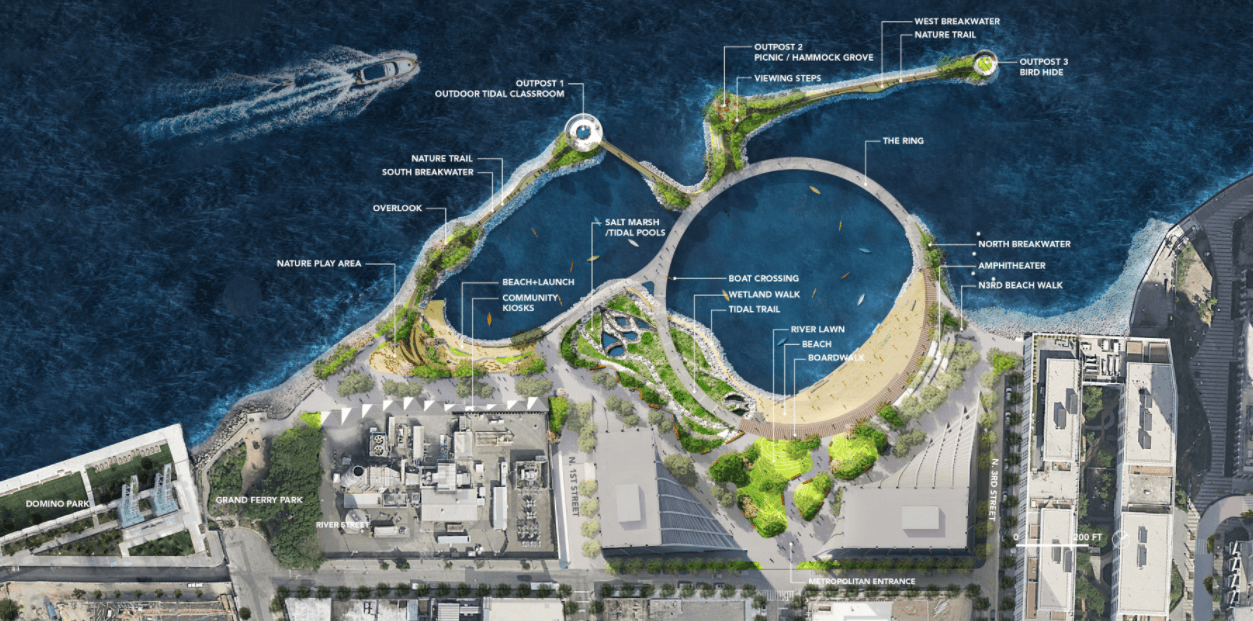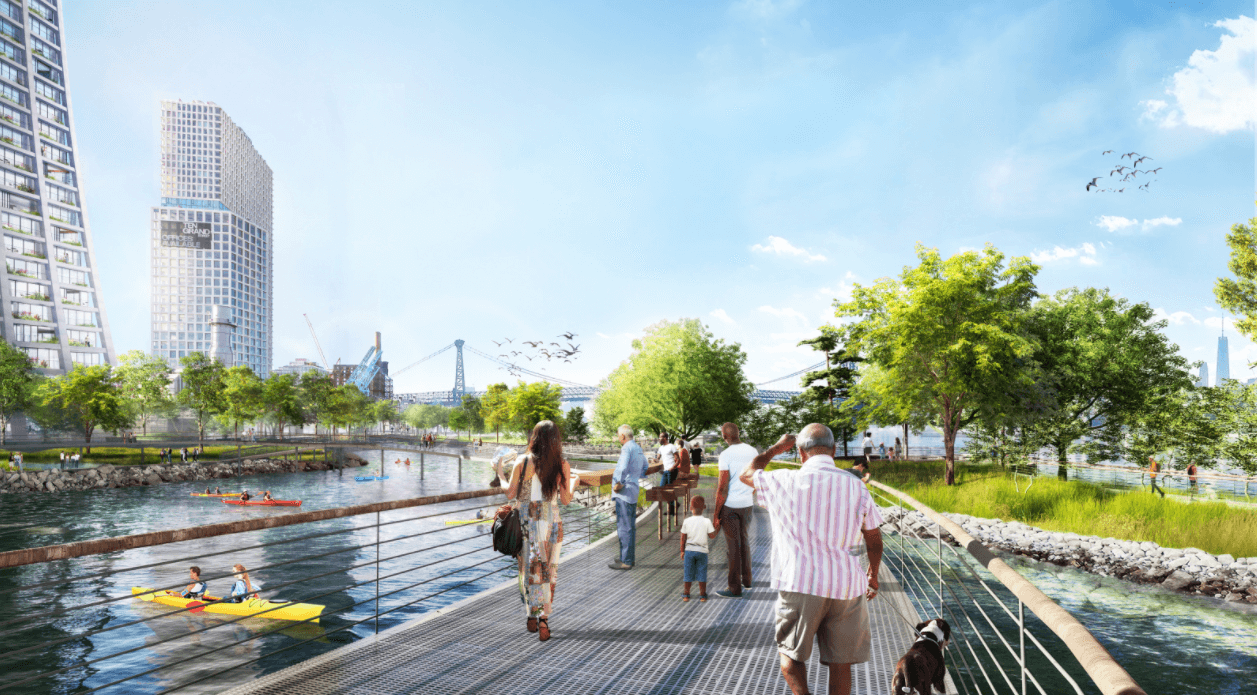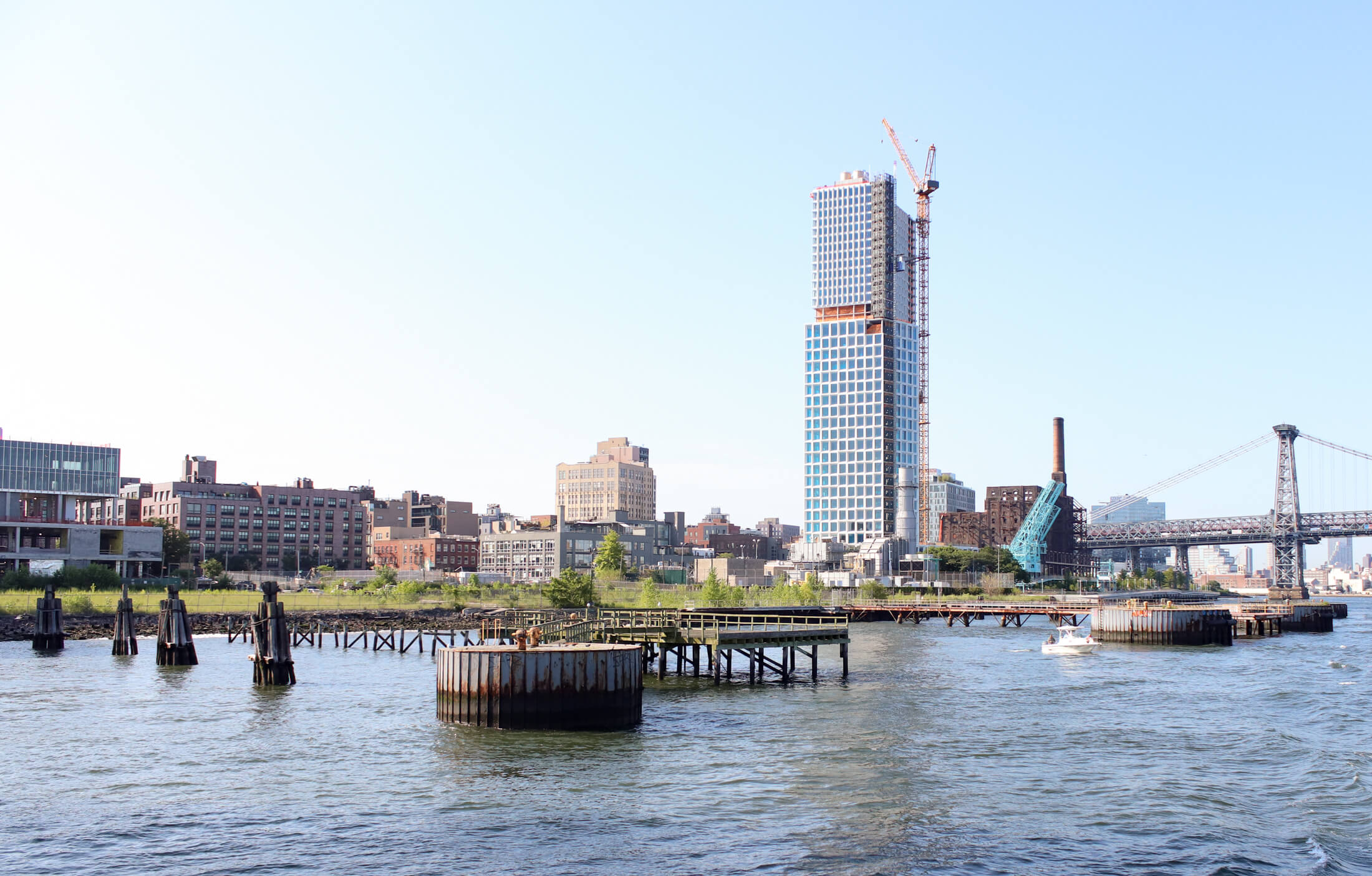Two Trees' Williamsburg Towers Head to City Council Hearing After City Planning Approval
Two Trees’ massive new waterfront development, River Ring, received a thumbs up from the City Planning Commission last week immediately before heading to the City Council for a public hearing.

Rendering by James Corner Field Operations and BIG-Bjarke Ingels Group
Two Trees’ massive new waterfront development, River Ring, received a thumbs up from the City Planning Commission last week immediately before heading to the City Council for a public hearing.
The CPC voted unanimously to approve the project on Wednesday, setting the stage for the council’s hearing on Thursday morning and a vote sometime before January 6, the end of the council’s 50-day deadline under the city’s Uniform Land Use Review Process.
In their report, the commission said they felt the proposed project fills a need for more housing in Williamsburg, one of the city’s fastest growing neighborhoods, and that the change from a commercial to residential zoning code is in line with the 2005 rezoning. The lot was not included in that rezoning because it was still an active industrial site owned by Con Edison at the time.
If approved, River Ring would bring two mixed-use towers — about 600 and 700 feet tall, respectively — and a large waterfront park to Williamsburg, just north of the former Domino Sugar Factory, another Two Trees development. Current plans include 1,050 apartments, office space, and retail and office space, along with new breakwaters, outdoor classroom space, and water access as part of the park space.
Brooklyn Community Board 1 approved the project “with conditions” at an hours-long meeting in September, giving their advisory blessing for the project to go forward, so long as it includes a long string of changes such as cutting the number of apartments, redesigning the towers, and renting out the remaining vacant affordable units at a nearby Two Trees building, One South First.

Borough President Eric Adams followed suit in early October, issuing a conditional approval that addressed some of CB1’s concerns. According to his approval, Two Trees committed to beginning the housing lottery for the 66 affordable units at One South First within six to eight weeks. A spokesperson confirmed to Brooklyn Paper that the company is working with the city’s Department of Housing Preservation and Development to open that lottery soon.
The developer also told Adams that they were open to increasing the number of affordable units at River Ring, and “willing to include more family-sized units,” and considering the minimum bedroom size of 128 square feet in affordable units, as requested by CB1. Reducing the project’s size, they said, was not feasible.
Adams’ recommendations are also not binding, and it’s likely that the project will receive council and mayoral approval before Adams’ term begins in January, but construction will likely begin during his tenure.
Council Member Francisco Moya, who represents parts of Queens and chairs the council’s Subcommittee on Zoning and Franchises, asked during Thursday’s hearing why the proposed park has a soft, sandy edge, rather than a hard bulkhead like the one at Domino Park, and if Two Trees had considered the future impacts of sea level rise and climate change on the dense waterfront development.
Bulkheads left in the water offshore by Con Edison, the property’s prior owner, slow and soften the East River’s strong current, Two Trees’ Bonnie Campbell said, allowing the construction of a soft edge that won’t wear away and providing a safe area for activities like kayaking. The bulkheads also provide the base of the park’s in-water walking paths and other features.
“What’s interesting about this park is it can, the way that it’s constructed, over time, you can actually build it up as sea level rises,” she said. “In terms of the buildings, one, pushing them to the highest part of the site and two, taking all the life safety systems and putting them all above the second floor.”

Moya also asked the two about the success of Two Trees’ prior affordable housing commitments at the Domino site.
“It’s created much more diversity in the immediate neighborhood and enabled families, who either have lived in the community board or currently live in the community to stay there,” Campbell said.
Two Trees’ Dave Lombino said the developer will continue to “aggressively” market new and remaining affordable units to the local community.
In response to a question from Councilman Stephen Levin, who represents the district where River Ring is planned, Campbell said the team had been working closely with his office to “deepen the affordability well beyond what’s required by MIH (Mandatory Inclusionary Housing,)” including altering the percentage of Area Median Income the units are rented at or looking into expanding affordable housing outside River Ring’s scope.
“Whether it’s senior housing that’s within some radius of the project, or more housing on site, we’re open to a lot of options, and want to continue to work with your office to figure out how to best serve that need.”
Two Trees is working on identifying sites that could be used for affordable housing, she said, and expected to have updates for Levin’s office in coming weeks.
Levin, whose term expires in January, also asked about the developer’s plan for the number of multi-bedroom apartments, a particular concern for CB1 and the beep.
“We know that at Domino, the demand has been trending larger from when we first started,” Campbell said. “It does seem the neighborhood as a whole is trending in that direction, more family-sized units, I will say.”
A final determination on the number of family-sized apartments will be made closer to the actual start of construction, she said.

“And then, also see what the programmatic requirements are for affordable housing at that time,” she said. “Whether they have to match the market-rate mix, or we can deviate and potentially have some larger affordable units. We’re definitely open to doing so, so long as the programs will allow us to do that.”
On the heels of a full day of hearings about banning new fossil fuel hookups in new construction, Levin also wanted to know if the development might be all electric.
“While we can’t commit to it today because we’re still learning what it means to be a fully electric building, it’s quite possible that our future Domino buildings will be, and by the time we get to the River Ring building, I imagine that’s where New York City will be, and where I imagine our organization will be as well,” Campbell said.
The company is exploring constructing a “micro-grid,” which would essentially allow the building to operate without relying on the municipal grid by storing unused energy during off-peak hours, then sending it back into the grid during peak demand.
“That will also enable us to power the River Ring buildings through that micro-grid battery system, which will further enable us to be completely electric, but also to supplement and fortify the neighborhood grid,” Campbell said.
River Ring’s website describes the micro-grid as “a technology that harnesses energy from solar, natural gas or biogas to produce and store energy through advanced battery storage.” A Two Trees representative said the company has a prototype micro-grid at a Gowanus development.
Levin’s vote will be instrumental in the project’s future, as the City Council usually informally adheres to “member deference,” voting with the council member who represents the district where a project is located.
The council Land Use Committee and the full council are expected to vote on the project during the week of December 13.
Editor’s note: A version of this story originally ran in Brooklyn Paper. Click here to see the original story.
Related Stories
- Two Trees’ Bjarke Ingels-Designed Williamsburg Towers Receive Approval From Community Board
- Locals Ask About Affordable Housing at Packed Hearing on Two Trees’ Latest Williamsburg Towers
- Local Community Groups Voice Tentative Support for Williamsburg Towers, With Some Caveats
Email tips@brownstoner.com with further comments, questions or tips. Follow Brownstoner on Twitter and Instagram, and like us on Facebook.









What's Your Take? Leave a Comment